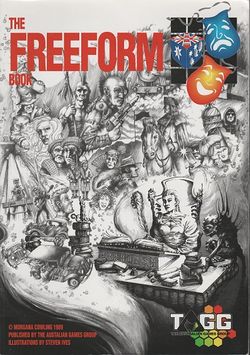The Freeform Book: Difference between revisions
IdiotSavant (talk | contribs) mNo edit summary |
IdiotSavant (talk | contribs) mNo edit summary |
||
| Line 7: | Line 7: | ||
And that's just what a Freeform is. The players are the actors. They set about achieving their [sic] objectives of the characters. The script is all ad-lib... A little character background is given... to get the players going, and of course, the objectives each players hopes to achieve. Thus the freeform is born.<ref>Morgana Cowling, ''The Freeform book'' (TAGG, 1989), p. 5.</ref></blockquote> | And that's just what a Freeform is. The players are the actors. They set about achieving their [sic] objectives of the characters. The script is all ad-lib... A little character background is given... to get the players going, and of course, the objectives each players hopes to achieve. Thus the freeform is born.<ref>Morgana Cowling, ''The Freeform book'' (TAGG, 1989), p. 5.</ref></blockquote> | ||
Cowling suggests three broad types of game: "the whodunnit", where the players must identify the murderer(s); "plot, subplot, scheme and scandal" | Cowling suggests three broad types of game: "the whodunnit", where the players must identify the murderer(s); "plot, subplot, scheme and scandal" focused on politics and negotiation; and "the common denominator" in which every character is pursuing the same (or one of a limited set of) goal. | ||
==Games== | ==Games== | ||
Revision as of 03:54, 5 January 2015
- Author
- Morgana Cowling
- Publisher
- The Australian Games Group
- Year
- 1989
- ISBN
- 1-875280-00-6
- Pages
- 100
The Freeform Book is an early introduction to "freeform" or theatre-style live action roleplaying. It was published by The Australian Games Group in 1989. The book includes chapters on playing, running and writing freeforms, as well as simple dice-based mechanics.
Definition of "freeform"
The Freeform Book includes one of the first definitons of a freeform or theatre-style larp, comparing it to a play where the actors know a little bit about their characters but have lost the script:
And that's just what a Freeform is. The players are the actors. They set about achieving their [sic] objectives of the characters. The script is all ad-lib... A little character background is given... to get the players going, and of course, the objectives each players hopes to achieve. Thus the freeform is born.[1]
Cowling suggests three broad types of game: "the whodunnit", where the players must identify the murderer(s); "plot, subplot, scheme and scandal" focused on politics and negotiation; and "the common denominator" in which every character is pursuing the same (or one of a limited set of) goal.
Games
The Freeform Book includes three small games:
- Lunch With Mason (11 players)
- Temple of the Winds (15 players)
- By Royal Appointment (14 players)
All three games use the dice-based mechanics featured earlier in the book.
References
- ↑ Morgana Cowling, The Freeform book (TAGG, 1989), p. 5.
